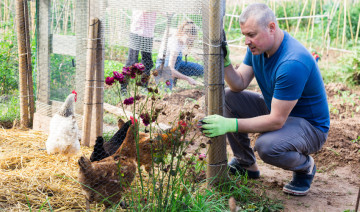{article.name} Monthly Blog Articles
WE DELIVER
Peterborough, NH: 603-924-6801 Brattleboro, VT: 802-254-8755 Walpole, NH: 603-756-9400 Hillsboro, NH: 603-464-3755 Milford, NH: 603-673-1669 Keene, NH: 603-357-5720How to Build a Chicken Coop

- Share this:
- Share on Facebook
- Pin on Pinterest
- Tweet on Twitter
Chickens can be a valuable addition to any urban homestead, hobby farm, or budget-friendly household. But to keep chickens safe and comfortable, a coop is essential. Knowing how to build a chicken coop can help you provide a proper home for your flock.
Why Chickens Need a Coop
A chicken coop is more than just a quaint decoration or kitschy structure. A chicken coop provides…
- Shelter from inclement or stressful weather, including rain, snow, wind, or sun
- Protection from predators and nest raiders like raccoons, hawks, rats, and snakes
- Comfort and privacy for nesting or roosting hens to improve their productivity
- Dedicated space for the flock to eat and drink so their diet can be monitored
- Easier options for caring for the flock, studying behavior, and collecting eggs
While a small flock in a protected location with mild weather may not necessarily need a dedicated coop, the benefits of a chicken coop can improve the welfare of any backyard flock.
Elements of a Good Chicken Coop
A good chicken coop is more than just a simple building. There are many different coop styles, sizes, and designs, but all provide perches and nesting boxes for the birds. An outdoor run gives the chickens a safe space to explore, and secure fencing keeps the flock safe from predators. A good coop will be appropriately sized for the number of chickens in the flock, and will have features to protect the birds’ health, such as proper ventilation, adequate light, and easy means for cleaning up droppings. Some coops are permanent structures, while smaller designs may be mobile so they can be moved between different positions to protect the ground and give chickens more stimulation. There is no single coop design perfect for every flock, and it is important to build a coop that will best suit your individual birds.
Options for Building a Coop
Anyone can build a chicken coop, depending on their carpentry or handyman experience as well as the complexity of the coop design. Ready-made coops or pre-made kits are widely available, or you can design your own coop from scratch using new or recycled materials as desired. Free chicken coop building plans are also available online, or more detailed plans can be purchased.
Depending on the size, style, and materials, the project may cost as little as $100 or could cost $1,000 or higher. Simple coops could be built in a weekend, while larger or more elaborate designs may take several weeks to finish. It is best to examine several different coop designs to choose the one that will work best for your flock. Take care, however, not to overestimate your building skills before beginning the project or your chickens could be left without proper cover and it can be more expensive to hire a contractor to correct coop problems.
Tips for How to Build a Chicken Coop
There is great flexibility when building a chicken coop, but considering different factors before beginning can help you not only choose the best design for your flock, but also be sure you build it correctly.
- Choose a good location.
A chicken coop should be in a level area, ideally with some shade such as under a deciduous tree. Placing the coop near a well-traveled area, such as closer to the house, will also provide more protection, as predators will be less likely to approach the coop. Avoid areas with poor drainage as wet or muddy ground can cause problems for chickens. Similarly, avoid areas that are prone to high winds that can create excessive winter chill.
- Provide enough space.
Chickens need 2-3 square feet of space per bird inside the coop’s house, and at least 4-5 square feet of space in an outdoor run area. Larger or more aggressive breeds may require more space, while smaller birds or smaller flocks can make do with more limited coops. Ideally, a larger coop will not only accommodate more birds, but will help reduce aggression and squabbling. Be sure the coop includes plenty of space for food and water as well.
- Use rot-resistant lumber.
Cedar and redwood are excellent choices for building a chicken coop, but they aren’t the only options. It is best to avoid pressure-treated woods, however, which may have used toxic chemicals that could be dangerous for the chickens. The roof could be metal or there are other building materials that can be used for chicken coops.
- Build the frame first.
Building the coop frame first will give you a better understanding of the project’s scope and the overall size of the coop. This will help you make any necessary adjustments to the plan or design to better suit your space and your flock’s needs. Outline where the fence will be situated, and consider a concrete foundation underneath the coop’s building to make cleaning droppings faster and easier.
- Elevate the enclosure.
Raising the coop’s house a foot or two above the ground will help protect roosting chickens from predators, and will make it easier to clean beneath the coop. This is especially critical if the coop has a grate floor to improve how feces can be removed. A gentle ramp can give birds easy access to the structure, and the ramp should have good grip or treads so the birds don’t slip as they go in and out.
- Provide windows.
Chickens need natural light to thrive, and a good coop will have ample windows or a skylight. At least some of the windows should be able to open to provide ventilation to help with respiratory conditions as needed. Additional vents near the coop’s roof will also help with ventilation and temperature control, but the coop should not be drafty.
- Provide proper chicken furniture.
A well-designed coop will include ample perches for every bird to use and stay off the ground, as well as properly-sized roosting boxes for the hens. This will also make egg collecting much easier, and the birds will more comfortable and at ease.
- Use proper fencing.
Every chicken coop needs a sturdy fence to keep the chickens protected and safely contained. The best fencing will depend on the chicken breeds, and part of the fence should be buried to help deter digging predators. A strong gate with easy hinges and a secure latch should also be part of the coop’s fence.
- Consider storage space.
Add more functionality to your coop and make it easier to care for your flock by including storage space for tools and extra feed. This convenience will make it easier to take care of the chickens, as well as monitor your supplies and know when restocking is necessary.
Be Creative!
While the chickens’ needs and the functionality of the coop should be your first priorities, you can also have fun with building a chicken coop. Consider matching the design to the structure of your home, or using bright, fun colors or flowering window boxes for a pop of personality. Adding rustic signage – the chickens’ names, “Fresh Eggs” or other whimsical sayings – can also be a cute touch. Consider unconventional structures such as repurposing a children’s playhouse or a doghouse, or design the coop in a fun ways such as a silo structure, church theme, or other unusual shape. So long as you create a structure that will safely shelter your flock, you can build a chicken coop in any way you please to have fun and bring joy to you and your chickens.



Comments